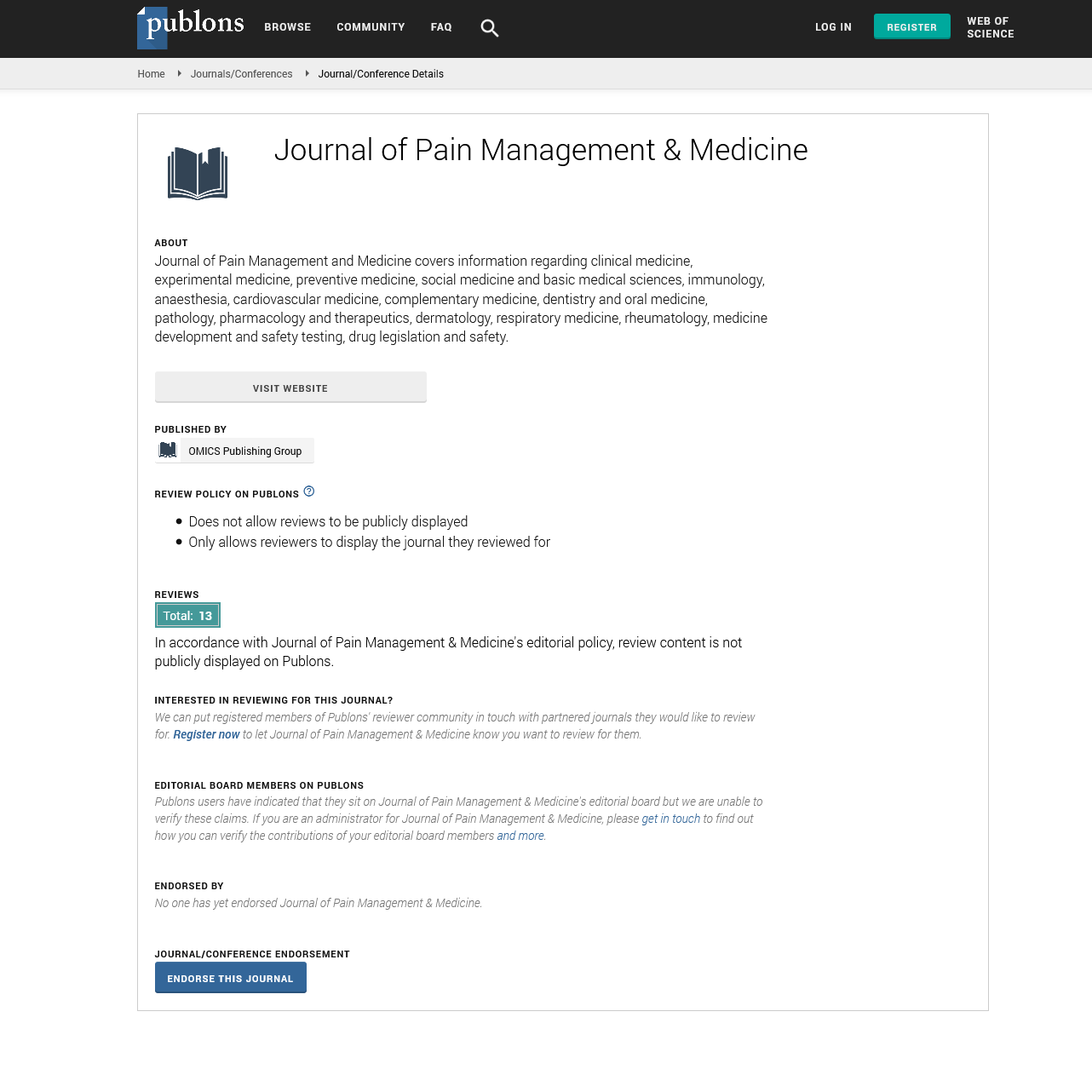Indexed In
- RefSeek
- Hamdard University
- EBSCO A-Z
- Publons
- Euro Pub
- Google Scholar
- Quality Open Access Market
Useful Links
Share This Page
Journal Flyer

Open Access Journals
- Agri and Aquaculture
- Biochemistry
- Bioinformatics & Systems Biology
- Business & Management
- Chemistry
- Clinical Sciences
- Engineering
- Food & Nutrition
- General Science
- Genetics & Molecular Biology
- Immunology & Microbiology
- Medical Sciences
- Neuroscience & Psychology
- Nursing & Health Care
- Pharmaceutical Sciences
Opinion Article - (2024) Volume 10, Issue 5
Acute Pain and Its Role in Healing: Causes, Pathways and Relief
Zhang Liang*Received: 26-Aug-2024, Manuscript No. JPMME-24-27466; Editor assigned: 28-Aug-2024, Pre QC No. JPMME-24-27466 (PQ); Reviewed: 11-Sep-2024, QC No. JPMME-24-27466; Revised: 18-Sep-2024, Manuscript No. JPMME-24-27466 (R); Published: 25-Sep-2024, DOI: 10.35248/2684-1320.24.10.291
Description
Pain is a complicated and subjective experience that serves as the body's defensive mechanism. Particularly, acute pain is a type of pain that arises suddenly, usually as a result of injury, surgery, illness or inflammation. It is typically short-term, lasting from a few seconds to several weeks and it generally subsides as the underlying cause heals or it is treated. While it can be distressing, acute pain plays a significant role in protecting the body by encouraging individuals to rest or avoid harmful activities that can contributed to the condition.
Acute pain is usually characterized as acute, abrupt and localized to a specific part of the body. Chronic pain, which persists for longer than three to six months and can exist without a clear cause, acute pain serves a more immediate biological purpose: It alerts the body to injury or illness that needs attention. Acute pain can be mild, such as a minor cut or headache or severe, as observed in broken bones, post-surgical pain or labor pain during childbirth. The duration of acute pain is another distinguishing factor. It typically lasts for less than three months and decreases as the underlying issue resolves. In many cases, acute pain serves as an opportunity for recovery, resulting in people relax or change their behavior to avoid additional harm.
Physiology of acute pain
The experience of acute pain is initiated when nociceptors or specialized sensory neurons, detect harmful stimuli such as extreme heat, pressure or chemical signals released by damaged tissues. These nociceptors are found in the skin, muscles, joints and internal organs and they are responsible for transmitting pain signals to the brain. When an injury occurs, nociceptors send electrical impulses through the peripheral nerves to the spinal cord and ultimately to the brain, where the sensation of pain is processed and perceived. This process is known as nociception and it involves several key stages. While this pathway explains the physiological mechanics of pain, the subjective experience varies greatly between individuals. Factors such as genetics, emotional state, mental health and personal history all contribute to how intensely pain is perceived and how effectively it is managed.
Transduction: Nociceptors convert harmful stimuli (mechanical, thermal or chemical) into electrical signals.
Transmission: These electrical signals are relayed through peripheral nerves to the spinal cord and then to the brain.
Perception: The brain interprets the signals as pain, producing a conscious experience of discomfort or distress. This is influenced by an individual's emotional state, past experiences and other cognitive factors.
Modulation: The brain and spinal cord can regulate pain signals, either amplifying or dampening the sensation. This modulation involves neurotransmitters including endorphins, which can reduce the perception of pain.
Common causes of acute pain
Acute pain can result from various conditions or events, ranging from injuries to medical procedures. Some of the most common causes include.
Injury: Physical trauma, such as fractures, sprains, cuts or burns, frequently leads to acute pain. The pain usually coincides with tissue damage and inflammation, subsiding as the injury heals.
Surgery: Post-surgical pain is a type of acute pain that arises from the trauma caused by surgical incisions and manipulation of tissues. Managing pain after surgery is important for developing recovery and preventing complications, such as delayed healing or prolonged immobility.
Infection or inflammation: Infections such as ear infections, dental abscesses, or appendicitis can trigger acute pain due to the inflammatory response in the affected area.
Childbirth: Labor pain is a form of acute pain experienced during childbirth. It is caused by uterine contractions, pressure on the cervix and the descent of the baby through the birth canal.
Acute illnesses: Conditions such as kidney stones, gallbladder attacks or acute pancreatitis can cause sudden, intense pain. These types of acute pain usually require immediate medical attention.
Medical procedures: Certain diagnostic tests or treatments, such as biopsies, injections or wound debridement, can cause temporary acute pain.
Citation: Liang Z (2024). Acute Pain and Its Role in Healing: Causes, Pathways and Relief. J Pain Manage Med.10:291.
Copyright: © 2024 Liang Z. This is an open access article distributed under the terms of the Creative Commons Attribution License, which permits unrestricted use, distribution and reproduction in any medium, provided the original author and source are credited.

